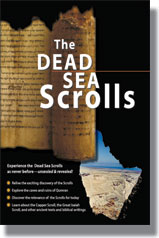
$12.00
This book was inspired by a fascinating exhibit supported by the Israel Antiquities Authority and the Dead Sea Scrolls Foundation and appearing at museums throughout the United States. In fact, the book was designed to supplement the exhibit, providing visitors and other interested readers with a full historical and photographic account of the Dead Sea Scrolls, from their initial discovery in 1947 to their recent publication and ongoing interpretation. Within this volume readers will learn not only how the Dead Sea Scrolls were found but also why many scholars believe that other scrolls still await discovery. In addition to becoming acquainted with both the Scrolls themselves and the ancient group who originally wrote them, readers will find out why the Dead Sea Scrolls continue to be significant for the Jewish and Christian religions today.
Each of the chapters included, which first appeared in Biblical Archaeology Review or Bible Review, has been written by a recognized expert on the Dead Sea Scrolls. For a preview of chapter 1 of this volume, click
Harry Thomas Frank, “How the Dead Sea Scrolls Were Found”
Frank draws on his experience as an archaeologist and historian to recount the exciting tale of the Scrolls’ discovery and acquisition.
Baruch Safrai, “More Scrolls Lie Buried! Recollections from Years Gone By”
Safrai, who continues to excavate in the region, supplements Frank’s account by presenting evidence that additional scrolls and archaeological “treasures” remain undiscovered within the barren Judean Desert.
Frank Moore Cross, “The Dead Sea Scrolls and the People Who Wrote Them”
Harvard University professor and Dead Sea Scrolls’ translator Frank Moore Cross introduces readers to the Scrolls and their likely authors, the ancient Essenes.
Emanuel Tov, “Publishing the Scrolls: Reflections on Thirty Years of Scholarly Work”
Tov, editor-in-chief of the official publication series of the Scrolls, describes the obstacles that he and other scholars faced and overcame to ensure the full publication of the Scrolls.
Sidnie White Crawford, “The Fluid Bible: The Blurry Line between Biblical and Nonbiblical Texts”
Crawford melds her expertise as a Scrolls editor and textual critic to show what the Dead Sea Scrolls teach us about the fluidity of the biblical text during the early years of the Common Era.
James C. VanderKam, “The Scrolls and Early Christianity: How They Are Related and What They Share”
VanderKam, University of Notre Dame professor and likewise a Scrolls editor, identifies how the Qumran community and early Christianity were similar in some ways yet each unique.
Lawrence H. Schiffman, “Significance of the Scrolls: A New Perspective on the Texts from the Qumran Caves”
Schiffman, author of numerous volumes on the Scrolls and ancient Judaism, offers a new perspective on what the Scrolls teach us about the varieties of Judaism of the last century B.C.E. and the first century C.E.
